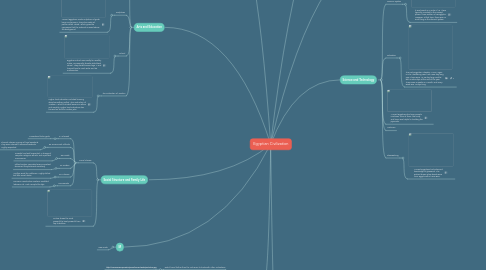
1. M
1.1. New node
2. Economy and trade
2.1. Didn't travel further than the Nile River to trade with other civilizations
2.1.1. http://courses.wcupa.edu/jones/his101/web/pix/nile-s.jpg
2.2. Traded gold, papyrus, linen, and grain for cedar wood, ebony, copper, iron, ivory, and lapis lazuli
2.3. Merchants were under scribes and in the social class and were respected
2.4. Had large warehouses were they stored grain for hard timies
2.5. Precious metal was used only by wealthy
3. Arts and Education
3.1. Paintings
3.1.1. Egyptian painters covered limestone walls with plaster. The paints were made with pigments from minerals found naturally around them.
3.2. Sculptures
3.2.1. Ancient Egyptians made sculptures of gods, kings, and queens. They also made art pieces called 'reliefs', which gives the impression that the material is raised above the background.
3.3. School
3.3.1. Egyptian school was mostly for wealthy males. Occasionally females did attend school. They started around age 7, and learned how to read, write, and do mathematics.
3.4. The Instruction of Wisdom
3.4.1. Higher level education included learning about something called "The Instruction of Wisdom", which included lessons on ethics and morality. Higher level education also focused on skills for certain jobs.
4. Social Structure and Family Life
4.1. Social Classes
4.1.1. #1 Pharaoh
4.1.1.1. Considered to be gods.
4.1.2. #2 Goverrment Officials
4.1.2.1. Pharaoh choose a group of loyal assistants. They were Pharaoh's advisors/assistants. Highly respected.
4.1.3. #3 Priests
4.1.3.1. Powerful and well respected. In charge of Temples, Religious Rituals, and Important Ceremonies
4.1.4. #4 Scribes
4.1.4.1. Official writers, Recorded every important document they believed necessary.
4.1.5. #5 Artisians
4.1.5.1. Another word for Craftsman. Highly skilled but little social status.
4.1.6. #6 Peseants
4.1.6.1. Farmers, Construction workers, unskilled laborers, etc. Had a simple life style
4.2. Picture shows the most powerful to least powerful from top to bottom
5. Governments and Leaders
5.1. .
5.2. Nomarks were the local governors under the supervision of the Vizier. The job was handed down by Hereditary.
5.3. There were three Viziers in Egypt each controlling Upper Egypt, Lower Egypt and the Kush
5.4. The Punishment if you broke a law where brutal. There where three ways that ended with the male or female to death. Decapition or drowning, execution or being burned alive.
5.5. The second most powerful people were the wives of the Pharaohs
5.6. Vizier is the primary leader of the Government under the rule of the Pharaoh. The Government was a Monarchy
5.7. The Pharaoh was the overlord or supreme leader of both government and religion.
6. Priests served also served as doctors, healers, astronomers, psychologists, scientists, and interpreters of dreams. Priests had lots of power in ancient Egypt.
7. Science and Technology
7.1. Numeric System
7.1.1. It was based on a scale of 10. It was typically rounded to the nearest power. It was written in hieroglyphs. However, at that time, there was no such thing as the decimal system.
7.2. Calendars
7.2.1. The early Egyptian calendar, Annus Vagus, or The Wandering Year, had a 365 day long year. There were 12, 30 day long months, with 5 extra days at the end of the year. There were 3 weeks in a month, and every week was 10 days long.
7.3. Ancient Egyptians had many simple machines. One of them, the ramp and lever, was helpful in building the pyramids.
7.4. Machines
7.5. Glassworking
7.5.1. Ancient Egyptians had advanced knowledge of glasswork. The earliest known glass beads were from Egypt around 1500 BCE.
8. Religion
8.1. The gods were seen as all-powerful and the divine creators of the earth. However, they were also seen as family and friends who wanted to help the people of Egypt.
8.2. The gods had a different thing that they were gods of. For example, Bastet is the god of the hearth, homeland, women's health, and cats.
8.2.1. http://www.landofpyramids.org/images/bastet-9.jpg
8.3. They believed in life after death, but not heaven as much as contact with the gods after death. They thought that if they died, they could still contact the gods and communicate with them.
8.3.1. https://i.ytimg.com/vi/w9DVUcPM-NI/maxresdefault.jpg
9. Geography and Agriculture
9.1. Geography
9.1.1. The Ancient Egyptians thought Egypt was split into two islands. The Black Land and the Red Land. The Black Land was the fertile land on the bank of the Nile River. This land was used for crops. this is because of a layer of black rich silt that was deposited after the Nile floods every year. The Red land is a desert the covers and protects the people from surrounding countries. The desert can also provide the people with precious metals and stones.
9.1.1.1. http://study.com/cimages/multimages/16/redblackland.jpg
9.1.1.2. http://megypt.yolasite.com/resources/barren%20desert.jpg
9.2. Agriculture
9.2.1. The agriculture of ancient Egypt involves plants animals and seasons. the type of plant that are grown on Egypt are wheat, barley, vegetables, figs, melons, and vines. Flax was also grown to make linen. The crops are grown on the bank of the Nile river. In ancient Egypt there were 3 seasons. Akhet the flooding season, Peret the growing season ( when the soil is most fetile), and Shemu the harvesting season. The types of animals they had were cattle, goats, pigs, ducks, and geese.
9.2.1.1. http://www.mummies2pyramids.info/images/asyut-region.jpg
9.2.1.2. http://www.crystalinks.com/egyptfarming.jpg
